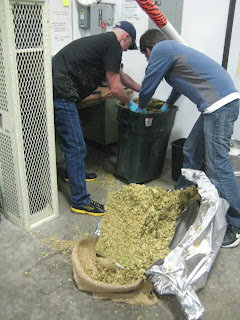I'm not going to outline the process or talk too much on the brewing itself as I would just be repeating the previous brewday. Instead, I'll mention a few of the changes between the batches. The last batch hit 1.040 gravity, which is fine, but its on the lower end of the spectrum. This time we upped the grain bill and hit 1.054. In doing this we also got a darker wort, and I really like the color that resulted.
Another factor that helped us hit a higher gravity was the evaporation rate during the 4 hour boil, which is higher in the winter than the summer. While I am happy to have the higher gravity, we only filled 13 barrels. A 14th barrel was filled half way, and we will use that to top off the other 13 barrels after the active fermentation stage finishes. In comparison, last year we easily filled 14 barrels and had probably 1.5 barrels worth of wort that had no barrel to go into and therefore went down the drain.
 |
| Filling the inoculated barrels |
 |
| Measuring out 30# and breaking up the whole hops. |
 |
| Transferring aged lambic into "new" barrels. |
All in all, it was another successful brew day. Although I was especially disappointed in not being able to fill that 14th and 15th barrel, it is good to reflect on the year and realize how far this project has come. I am thankful to O'so for brewing this beer with me, and I look forward to our annual brew day.
 |
| A sea of barrels. All but the 6 stacked are for lambic. |
Update:
It took 4 days to kick in, but fermentation is foaming over.
It started with these two on Tuesday night, and by Wednesday morning all of the barrels were foaming. While I like that there was a stressed fermentation that took a few days to start, the barrels were in the way of brewing operations and needed to be moved into the tap house. However, Wednesday morning it was learned that the concrete floors in that area do not slope to the floor drain and all of the foam pooled up and poured into the adjoining room; Marc's office. While I imagine it smells wonderful, it will require quite a bit of clean up, and the barrels were moved back over the floor drain. Reminds me of the mess I had with the pilot barrel!



